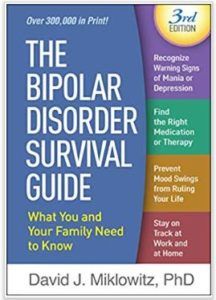Bipolar Disorder in Adults
Bipolar Disorder, formerly called ‘manic-depressive illness’ is a biologically based mental illness that can be managed with an accurate diagnosis, having up-to-date information about the condition, good medication management, supportive counseling, a good support network, and healthy lifestyle practices. There are several bipolar-spectrum disorders including:
- Bipolar I Disorder – Individuals with Bipolar I disorder have both manic episodes and depressive episodes. At times, these individuals may have mixed episodes in which they have both symptoms of mania and depression simultaneously. Symptoms of manic episodes include high energy, grandiosity, increased activity, impulsive behaviors, rapid or pressured speech, racing thoughts, trouble sleeping or not sleeping, anger/irritability, and/or risky behaviors that may violate their values (e.g., wildly spending money, reckless sexual behavior). Christian individuals with bipolar disorder often exhibit symptoms with spiritual content. For example, the person may believe that God has given them a special mission or that they have spiritual insights that other people do not recognize. During manic episodes, individuals will often not realize their behavior is irrational or abnormal and, many times, they will refuse help. Psychiatric hospitalization is sometimes needed in order to get the person stabilized.
- Bipolar II Disorder – Individuals with Bipolar II Disorder have hypomanic episodes (less severe manias) along with depressive episodes. Individuals with Bipolar II Disorder often experience anxiety and insecurity along the course of their illness.
- Cyclothymic Disorder – Individuals with cyclothymia have both hypomanic and depressive symptoms for a period of at least two years. While the hypomanic and depressive symptoms don’t meet the criteria for Bipolar I or II, the symptoms are still very painful and disruptive to the person’s life.
- Other Bipolar Disorder – Sometimes individuals have bipolar disorder symptoms that do not fall within the other three categories but still need treatment to get their mood stabilized.
For Further Information:
Bipolar Disorder Signs and Symptoms
The information at this link will help you recognize mania, hypomania and bipolar depression as well as understand the treatments available. [Helpguide.org]
Bipolar Disorder Support and Self-Help
This link provides excellent advice for those with Bipolar Disorder to create a strong plan for managing the condition. [Helpguide.org]
Helping a Loved One with Bipolar Disorder
This provides guidance for those with a family member with Bipolar Disorder. [Helpguide.org]
Depression: What It Is and What Can Be Done About It
This document explains the different types of depression including spiritual, situational/reactive, clinical, and Seasonal Affective Disorder. [ACCFS]
Screening Tools
Mental Health Screening Center
At this link you can take free, confidential screening checklists for depression, anxiety, and mania. [Depression and Bipolar Support Alliance]
Bipolar Spectrum Diagnostic Scale
At this link you can take an online assessment for bipolar spectrum disorders. This tool is often helpful for assessing for Bipolar II and other bipolar conditions in which the person doesn’t exhibit clear manic episodes [PsychEducation.org]
Mood & Self-Care Tracking
Due to the variable nature of bipolar-spectrum disorders and the need to catch manic and depressive episodes early, daily mood tracking is an essential feature of successfully managing these conditions. Taking completed tracking charts to your appointments with your physician and counselor will help them to have a more accurate picture of how you are doing.
- ACCFS has a mood tracking chart available: Tracking Chart
- DBSA Wellness Tracker
This free, helpful web-based program also has handy iPhone and Android apps available for easy input of data. This program helps individuals with mood disorders track key health trends such as overall mood, well-being, mood disorder symptoms, lifestyle (including sleep, exercise, etc.), medication (and side effects), and physical health.
Support Options
Find a Depression and Bipolar Support Alliance Group Near You
This site provides information related to peer-run support groups for people dealing with depression and bipolar disorders.
Support Options from NAMI
The National Alliance on Mental Illness (NAMI) provides education and support for people struggling with mental illness and their families. This site has links to find NAMI support groups in your local area. NAMI also provides 12-week Family-to-Family education groups that can be very helpful for family members of someone dealing with mental illness.
988 Suicide & Crisis Lifeline
This Lifeline is for people experiencing a crisis and is available 24/7 in the United States. If you need help for yourself, a friend, or family member, call or text 988 right away.
Resources:
 The Bipolar Disorder Survival Guide, Third Edition: What You and Your Family Need to Know Third Edition
The Bipolar Disorder Survival Guide, Third Edition: What You and Your Family Need to Know Third Edition ![]()
Author: David Miklowitz PhD.
This 342-page book addresses the frantic highs and crushing lows of this illness and gives current information and practical problem-solving advice you can count on.
 The Bipolar II Disorder Workbook
The Bipolar II Disorder Workbook ![]()
Authors: Stephanie Roberts & Louisa Sylvia
This 200-page workbook can help people with Bipolar II Disorder manage recurring depression, hypomania, and anxiety.
 I Am Not Sick I Don’t Need Help!
I Am Not Sick I Don’t Need Help! ![]()
Author: Zavier Amador
This 254-page book is for someone who is trying to help a mentally ill family member or friend who has poor insight into their illness and therefore are not compliant with treatment or even able to recognize their need for treatment.





Comments
Leave a Comment